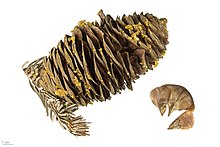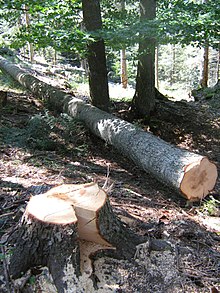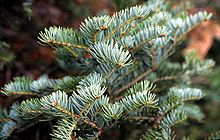Abies alba
Abies alba, the common fir or white fir is a tree species of the Pinaceae family, native to the mountainous regions of Europe. Pyramidal in shape, medium or tall in size, between 20 and 50 meters, it can reach 60 meters in height, its trunk is straight and columnar, devoid of branches in its lower part, up to 6 meters in circumference, with ashy to whitish bark, smooth and with resinous vesicles; It darkens and cracks in old specimens.
Features

It is an evergreen tree, with linear leaves of 1.5 to 3 cm, flat, solitary, not sharp, arranged in two thick rows with two whitish lines at the bottom; non-resinous buds. Its branches from the ground are almost horizontal. Erect strobili between 10 and 20 cm with tectric scales. The yellowish male cones measure 7-12 mm and appear grouped at the bottom of the twigs. The female cones, greenish, measure 10-18 cm in length, erect, greenish when developing.


Flowering
It blooms in spring, during the month of April. The cones mature the following autumn. The flowers are divided into female cones (the cones or strobiles) and male cones (where the pollen is found).
Habitat
On the slopes and shady areas of the mountains, mainly on fresh and deep soils, both rich and poor in lime, with an optimum between 700 and 1800 meters, but frequently reaching 2000 m. It requires a humid climate, with not very pronounced summer drought, with late frosts being very damaging. It is associated with the beech and also the Scots pine, when this is favored; or with the black pine at its upper limit.
Distribution
It is an abundant species in central Europe, distributed mainly in mountain ranges: it is very abundant in the Alps, the Pyrenees, the Carpathians and the Dinaric Alps. In principle, they are not very common in the Iberian Peninsula, although some areas of the Cantabrian coast and the Peneda-Geres National Park (Portugal) have been repopulated with this species. In Spain it develops especially in the Pyrenees, with its most important masses found in the Foral Community of Navarra and the provinces of Huesca, Lérida, Barcelona (Alto Bergueda, Rio refuge) and Gerona. It reaches its southernmost limit in Montseny and Sierra de Guara.
History
Dioscorides does not mention the fir tree, but Andrés Laguna classifies it along with other similar conifers such as the pine, and says "But the fir tree produces that excellent liquid unknown to the ancients, commonly called fir oil, which is caught by breaking certain vesicles that swell between bark and bark of said fir tree, in which it is miraculously generated. It is very clear, pure, transparent, fragrant and bitter and has the virtue of healing fresh wounds and decorating calluses. Taken by mouth, it resolves all windiness, is effective against jaw pain, purges sand from the kidneys and mitigates pain in the joints and nerves.
Observations
The scientific name of this fir, alba, undoubtedly alludes to the whitish color of its bark, rich in tannins.
The wood is white, light, not very resinous, easy to work with, it is widely used in construction, in fine cabinetmaking, for the making of musical instruments such as organs and in the manufacture of paper. The bark is rich in tannins.
Turpentine, which is obtained from cortical bladders, is a liquid with a resinous odor and somewhat bitter taste, which the Latins called lacryma abietis and which enjoyed great fame as a balsamic and vulnerary. Untreated, it is known as resin and is used to caulk boats.
Recognition
Non-decurrent leaf base (clean imprint when removing the leaf, twig axes soft to the touch), insertion of the circular petiole (and not protruding from the surface of the twig, smooth). Leaves normally notched at the apex, with a flattened section, long, dark green. Erect cones with deciduous scales and tetric bracts on the same projections.

Properties
It has properties similar to those of pine. The buds are rich in resin, and their main essences are limonene and alpha pinene. The leaves have a notable amount of essences, in addition to glycosides and picein. The bark is rich in tannins and phlobacene. The resin, in addition to being rich in turpentine, has a certain amount of abietinic acid.
- Internally it is used as balsamic and pectoral as it has anti-catroots, anti-grip and diuretic properties. Infusion will be taken at the rate of four daily tacitas.
- Externally, it is scarring and resolutive if applied on abscesses and tumors.
- Externally as friction, its trumentine essence acts as a remedy against rheumatic pains.
- It is used as a domestic disinfectant. However, it should be used with caution, as the essence of the fir produces in some people allergic phenomena.



Taxonomy
Abies alba was described by Philip Miller and published in The Gardeners Dictionary:...edition seven 110, 2. 1759.
- Etymology
Abies: generic name that comes from the Latin name of Abies alba.
alba: Latin epithet that means "white"
- Sinonimia
- Abis alba subsp. apennine Brullo, Scelsi & Spampinato
- Abis alba var. pardei (Gaussen) Silba
- Abis alba var. podolica R.I. Schröd.
- Abis argenta Chambray
- Abies baldensis (Zuccagni) Nyman
- Abies chlorocarpa Purk. ex Nyman
- Abies pardei Gaussen
- Peuce abies (Du Roi) Rich.
- Picea pectinata (Lam) Loudon
- Pinus abies var. pectinata H. Christ
- Pinus baldensis Zuccagni
- Pinus lucid Salisb.
- Pinus pectinata Lam.
Ambiguous synonyms:
- Abis excelsa Link
- Abies nobilis A. Dieter.
- Abis pectinata (Lam.) Lam. & DC.
- Abis picea Lindl.
- Abies taxifolia Desf.
- Abies vulgaris Poir.
- Picea excelsa Wender.
- Pinus abies Du Roi
- Pinus abies var. leioclada Steven ex Endl.
- Pinus heterophylla K. Koch
- Pinus picea L.
Common name
Spanish: fir, fir, white fir, white fir, common fir, Scottish fir, yew-leaf fir, yew-leaf fir, Normandy fir, noble fir, pectinate fir, silver fir, abetune, firs, spruce, fir, common fir, fir, pine-fir, sapino.
Contenido relacionado
Magnoliopsida
Cornus (desambiguación)
Rubiales
Sparaxis
Lathraea